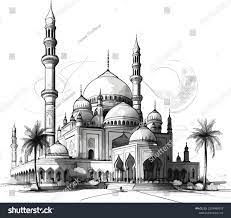Masajid's beauty is in their simplicity
- Aslam Abdullah
- Nov 20, 2021
- 4 min read
Updated: Jul 27
Quba Mosque was originally a well near a village named after it. The tribe of Bani Amr bin Auf. On his way to Medina

, the Prophet Muhammad (peace be upon him) visited the home of Bani Amr Bin Auf and built a mosque in the area, which he named Quba. Made of mud, wooden logs, and hay, it was a simple structure three KM away from the second Masjid built in the first year of the Hijri of the Islamic calendar. It was 35 meters long and 30 meters wide.
Palm trunks supported the room and included beaten clay and palm leaves. Its height was 3.60 m (11.8 ft). The three doors of the mosque were Bab-al-Rahmah (The Door of Mercy) to the south, Bab-al-Jibril (Door of Gabriel) to the west, and Bab al-Nisa (Door of the Women) to the east. Originally, these gates had no names. The total area was some 1,050 square meters. The companions used unbaked bricks as a building material on a masonry foundation about 1.5 meters high.
The initial construction of Masjid Nabawi started in Rabi al-Awwal of the year 1 Hj. (622 CE), with the Prophet himself taking part in laying its foundations.
After completing the first mosque, the Prophet installed a minbar made of "woodblock of date tree." He later replaced it with a tamarisk one, which had 50cm × 125cm (20in × 49in). In 629, he added a three stair ladder to it. There was no mihrab.
There was a roofed area towards the front of the Masjid. The majority of the courtyard was left open. The simple Masjid underwent many phases of expansion, the first being seven years after its construction.
Expansion of the Masjid did not alter its simplicity. Even though precious stones and marbles were available, the foundation had rocks and the walls unbaked mud bricks. The columns had palm trees, and the roof had branches of palm trees. The mosque wasn't just a place where people offered obligatory prayers. It was also a place where students came to learn, and the companions discussed their social and community affairs. The Prophet invited delegations and received them. He also made the Masjid a center for catering to the needs of the needy.
Do our Masajid reflect that original simplicity and function? Ninety-five percent of Masajid in the US become busy on Fridays as, during regular prayers on all seven days, the people attending religious service remain very low. There are 3,000 Masajid in America. Muslims raise millions every year to expand, maintain and run them. The beautification of Masajid cost a substantial amount. Installing new expensive marbles, adding exotic artifacts, installing precious carpets add to expenses. One wonders if the management can use that amount to build schools, clinics, or initiate programs to empower the needy and the poor financially.
The purpose of the Masjid is explicit in the Quran.
"And [know] that all worship is due to God [alone]: hence, do not invoke anyone side by side with God!" The Quran, 72:18
"Only he should visit or tend God's houses of worship who believes in God and the Last Day, and is constant in prayer, and spends in charity, and stands in awe of none but God: for [only such as] these may hope to be among the right-guided!" The Quran, 9:18
"Never set foot in such a place! Only a house of worship founded, from the very first day, upon God-consciousness is worthy of thy setting foot therein -[a house of worship] wherein there are men desirous of growing in purity: for God loves all who purify themselves. The Quran, 9:108
"In the Houses of worship, which God has allowed being raised so that His name be remembered in them, there [are such as] extol His limitless glory at morn and evening. " The Quran: 24:36
A Masjid with simplicity can serve this purpose. The marbles, the expensive carpets, or the exotic artifacts do not alter the purpose. Instead, they may come under israf or tabzir, which scholars define as extremely using income and wealth and paying money more than the standard level for goods and services. Both represent consumerism altogether.
When 60 percent of Muslims in different parts of the world suffer from extreme poverty, malnutrition, lack of proper education, drinkable water, health services, and basic amenities, the priority is not the beautification of Masajid structurally. Money could easily take care of the essential needs of people.
It is an issue that Muslims have to deliberate deeply with sincerity. A simple structure is as beautiful as the most exquisite one because the places of worship are not a show-off. They are the centers of providing guidance to people and serving them in their needs. Perhaps a balanced approach in building a Masjid can offer a solution. If we revert to the sunnah of the Prophet in designing our Masajid, we can use our resources to focus on issues that have left the vast majority of Muslims to live a life of dignity. Once Masajid focuses on the purpose as outlined by the Prophet. We can see people flocking to them not only on Fridays but during all prayers and beyond that. The Masajid will then become the hub of Muslim communities.



Comments